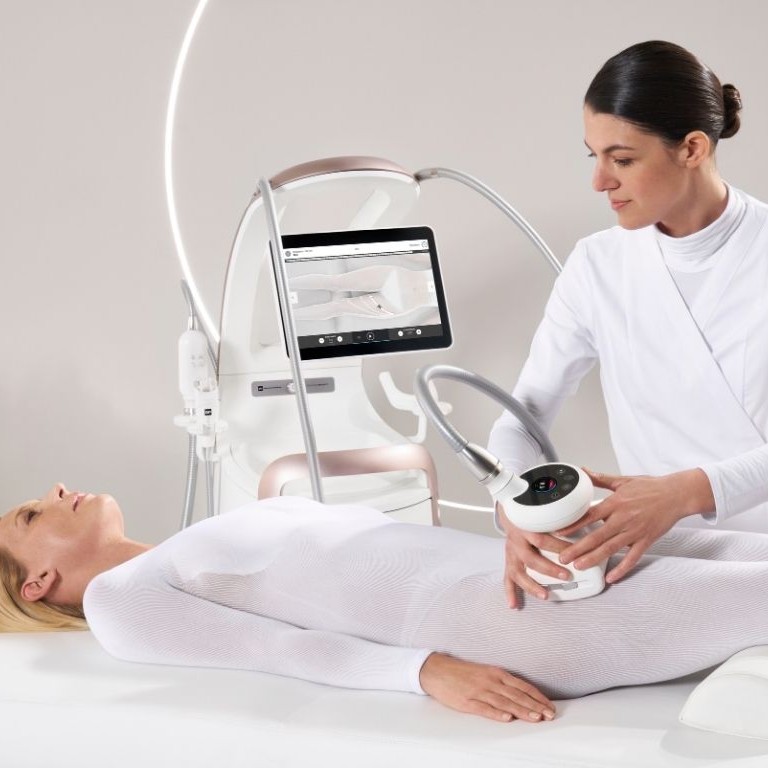As demand for non-invasive treatments grows, red LED light therapy stands out for improving ageing, acne and post-procedure healing
Red LED light therapy is a powerful tool in many beauty therapists’ treatment arsenals. But how does it actually work, and how can professionals best integrate it into modern skin treatments?
We take a deep dive into the science behind the treatment, and speak to experts about its practical use in the treatment room.
What is red light therapy?
Red light therapy is one of the most popular beauty treatments out there for several reasons. It can be used as a standalone treatment or easily added to other therapies. It's low effort for practitioners, non-invasive, requires no downtime and clients often see visible results.
The red light used in beauty devices comprises two parts of the electromagnetic spectrum: visible red light and near-infrared light (also called infrared-A). Visible light is the part of the spectrum that the human eye can see.
However, while it appears as a single colour, it’s actually made up of a range of colours – something visible when light travels through a prism. Near-infrared light lies just beyond the visible spectrum.
“There are two types of red light, namely warm and cold red light,” says Dr Alexander Wunsch, scientific consultant for JK Group. “In the context of beauty applications, cold red light is used. Cold red light is easiest to produce with LEDs and laser light sources.”
Red light therapy involves using LED devices to expose the skin to low levels of both red visible light and near-infrared light to stimulate cellular activity.
“Visible red light, with a wavelength ranging from 600 nanometres to 700 nanometres, reaches approximately 8-10mm into skin tissue. This makes red light particularly helpful for addressing skin issues affecting the upper dermis and epidermal layers,” explains Ellie Clark, global account development and training specialist at Déesse Pro.
Candice Gardner, education manager at Dermalogica, adds, “Red light (around 630-660 nm) and near-infrared (typically 800-850 nm) are often studied side by side. Both are widely used in photobiomodulation, but their effects differ slightly because of how deeply they penetrate the skin.
"NIR is used for rejuvenation and deeper healing as the wavelength reaches the skin's structural dermis, while red light is more surface-acting.”

Benefits of red light therapy
The benefits of red light therapy span from rejuvenation to inflammation reduction.
“A well-studied effect of red light is the stimulation of fibroblasts, which are responsible for the production of the collagen network and elastin synthesis in the skin,” comments Dr Wunsch.
“As red light and near-infrared have a high penetration depth, they can support and improve numerous cell-mediated skin functions gently yet effectively.”
From a clinical perspective, Dr Aiza Jamil, consultant dermatologist, explains, “I would say, early signs of ageing such as fine lines, dullness and loss of radiance.
"It also provides excellent results for calming inflammation, which makes it beneficial for sensitive or rosacea-prone skin. In acne management, red light reduces inflammation and supports healing of blemishes.
"It is also highly effective in speeding recovery after procedures like microneedling or chemical peels, where it helps to reduce redness and accelerate tissue repair.”
Gardner echoes this, highlighting that “the research shows that red LED is particularly effective for addressing visible signs of ageing such as fine lines and dullness, as well as calming the appearance of redness and inflammation.
"Many therapists also see improved outcomes when supporting skin recovery post-peel or post-microneedling, thanks to its soothing and restorative qualities.”

Best practices and safe use
Although red LED light is considered safe for most clients, proper consultation remains critical.
Gardner advises, “Therapists should review the client’s overall health, current skin condition, and lifestyle factors. Key considerations include whether the client is pregnant, has a history of photosensitivity, or is using medications or topical treatments that increase sensitivity to light.
"Always discuss expectations, as results build with consistency rather than a single session.”
According to Dr Jamil, “Clients taking certain antibiotics or isotretinoin should avoid the treatment. It is also not appropriate for anyone with epilepsy triggered by light, or with a history of skin cancer.
"While red LED is considered generally safe in pregnancy, many clinics choose to avoid it as a precaution. Active infections or uncontrolled skin conditions would also mean postponing treatment until the skin is stable.”
Gardner adds that LED should be avoided for clients with:
-
Photosensitive conditions such as lupus
-
Current use of photosensitising medications (e.g., certain antibiotics, isotretinoin, or some acne medications)
-
Active skin cancer or suspicious lesions in the treatment area
-
Recent cosmetic surgery without medical approval

Combining red light with professional treatments
Red light therapy is not just effective on its own; it amplifies results when paired with other professional skin services.
Dr Jamil explains, "Red light therapy enhances professional treatments by calming the skin, accelerating healing, and improving overall results. After microneedling or chemical peels, it shortens downtime and supports collagen production.
"When used after extractions or acne-focused treatments, it reduces inflammation and soothes the skin. Even when incorporated into a traditional facial, it helps to brighten the skin and be more refreshed.”
Gardner elaborates, “Red LED supports skin repair and calms visible irritation, making it an excellent complement to resurfacing or stimulating procedures.
"It helps reduce downtime, encourages healthier-looking skin post-treatment, and allows clients to enjoy both immediate soothing and longer-term cumulative benefits.”
Generally, skin that is more imbalanced will see more significant benefits from red light therapy than healthier skin.
Short-term issues, such as wound healing and inflammation reduction, yield faster results than chronic concerns, which usually require long-term application.
To maximise results, it’s essential to prep the skin before treatments. Clark explains, “Before red light therapy sessions, we recommend cleansing the skin thoroughly to remove any makeup, dirt or skincare products. Clean skin ensures better light penetration and maximises the effectiveness of LED light therapy.”
The popularity of red light therapy is partially due to its near-universal tolerance. “Notably, LED therapy boasts an impeccable safety record with no serious adverse incidents recorded across over 1,700 publications,” says Clark.
However, this doesn’t mean it’s safe for all clients, and a thorough consultation is essential.
“There is a group of autoimmune diseases referred to as ‘collagenoses’ where red light therapy has a negative effect and would be contraindicated,” explains Dr Wunsch.
“In general, it’s advisable to consult with the attending physician for all manifest diseases. And – this cannot be emphasised enough – the right dose is the best guarantee for an optimum effect. Always follow the manufacturer's instructions to avoid overdosing.”

Pairing with professional skincare
The results of red light therapy can be optimised by combining it with the right topical ingredients.
Dr Jamil highlights that “peptides and growth factors and also hydrating agents such as hyaluronic acid enhance plumping and moisture retention, while antioxidants like vitamin C or resveratrol protect cells and boost radiance.”
Gardner notes that formulas should be translucent to allow light penetration: “There are many botanicals and peptides that can complement the action of the light by also boosting ATP levels or providing critical components that support skin rejuvenation or repair.
"Ingredients such as lindera root extract, olive leaf extract, brown algae extract and magnesium aspartate help energise the skin, improve elasticity, and enhance radiance.”
However, she warns, “Avoid using retinoids and vitamin C during a LED therapy session. The light denatures them, rendering them ineffective.
"These ingredients are fine to implement as part of the at-home follow-on regimen, just not used directly under the LED light.”
Professional vs at-home devices
As consumer interest in LED grows, many clients invest in at-home masks. But experts stress the distinction.
Dr Jamil says, "Professional devices deliver stronger, medical-grade wavelengths with higher energy, meaning faster and more visible results. They are also applied with a therapist, very different to at-home devices, which are lower in intensity for consumer use – meaning less noticeable results.”
Gardner adds, “Professional devices are typically more powerful, deliver controlled wavelengths at optimised intensities, and are applied under the guidance of a trained therapist.
"At-home devices can be a useful maintenance tool, but they do not replace the depth of results achievable in a professional setting.”
Therapists can reassure clients that combining both can work well. “Position at-home devices as supportive in-between care while emphasising that professional treatments provide stronger, more targeted results in a monitored environment,” Gardner advises.
Treatment planning and aftercare
Consistency is key to results.
Gardner recommends:
-
Ageing: 1-2 times per week for 4-6 weeks, then monthly maintenance
-
Acne or inflammation: 2-3 times per week initially, then tapering as skin stabilises
-
Always be guided by skin condition, client goals, and device manufacturer instructions
Supporting aftercare is equally important. “When targeting ageing skin concerns pair with skin regenerating actives such as retinol, peptides and vitamin C.
"If treating breakouts, pair with niacinamide and anti-inflammatory actives such as beta-glucan and oat extracts. For post-procedure recovery, always follow appropriate aftercare for microneedling or peels,” Gardner explains.




